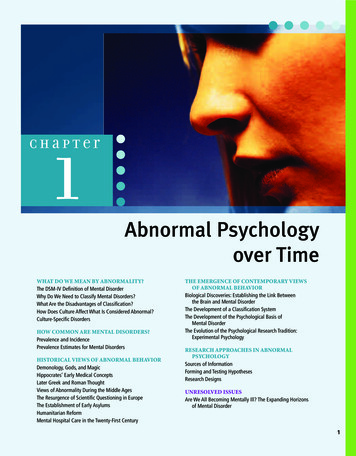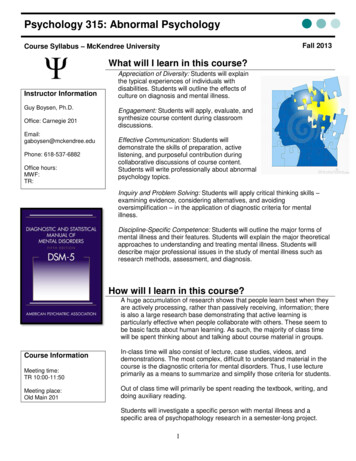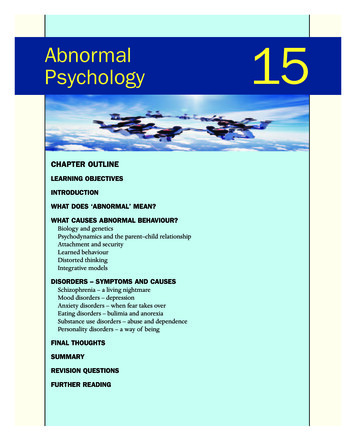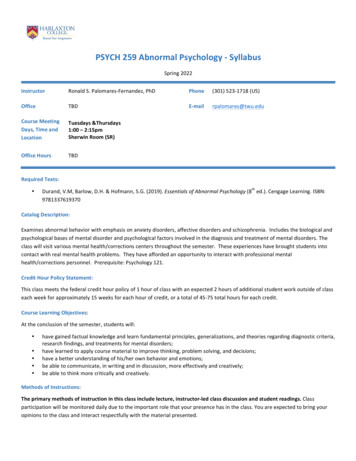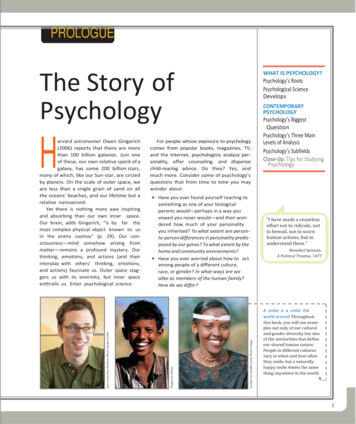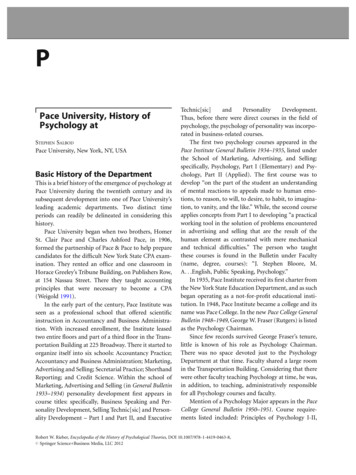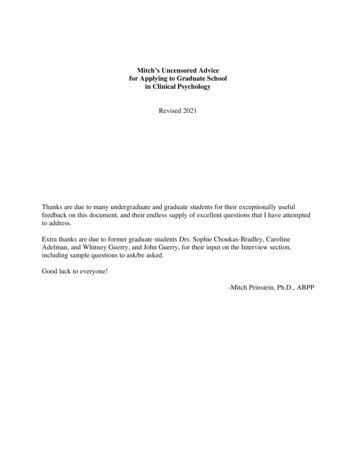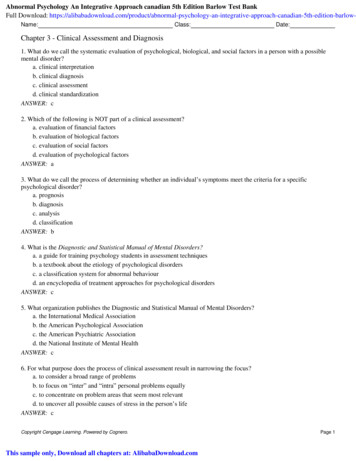
Transcription
Abnormal Psychology An Integrative Approach canadian 5th Edition Barlow Test BankFull Download: -barlowName:Class:Date:Chapter 3 - Clinical Assessment and Diagnosis1. What do we call the systematic evaluation of psychological, biological, and social factors in a person with a possiblemental disorder?a. clinical interpretationb. clinical diagnosisc. clinical assessmentd. clinical standardizationANSWER: c2. Which of the following is NOT part of a clinical assessment?a. evaluation of financial factorsb. evaluation of biological factorsc. evaluation of social factorsd. evaluation of psychological factorsANSWER: a3. What do we call the process of determining whether an individual’s symptoms meet the criteria for a specificpsychological disorder?a. prognosisb. diagnosisc. analysisd. classificationANSWER: b4. What is the Diagnostic and Statistical Manual of Mental Disorders?a. a guide for training psychology students in assessment techniquesb. a textbook about the etiology of psychological disordersc. a classification system for abnormal behaviourd. an encyclopedia of treatment approaches for psychological disordersANSWER: c5. What organization publishes the Diagnostic and Statistical Manual of Mental Disorders?a. the International Medical Associationb. the American Psychological Associationc. the American Psychiatric Associationd. the National Institute of Mental HealthANSWER: c6. For what purpose does the process of clinical assessment result in narrowing the focus?a. to consider a broad range of problemsb. to focus on “inter” and “intra” personal problems equallyc. to concentrate on problem areas that seem most relevantd. to uncover all possible causes of stress in the person’s lifeANSWER: cCopyright Cengage Learning. Powered by Cognero.This sample only, Download all chapters at: AlibabaDownload.comPage 1
Name:Class:Date:Chapter 3 - Clinical Assessment and Diagnosis7. A patient who had recurrent headaches, fatigue, and loss of appetite received different diagnoses from severalpsychiatrists. In terms of assessment, what type of problem does this example illustrate?a. a problem with classificationb. a problem with reliabilityc. a problem with validityd. a problem with standardizationANSWER: b8. Dr. Evans conducts a study that showed his colleague’s “depression screener” doesn’t predict depressive symptoms.What is the problem with the depression screener?a. validityb. standardizationc. reliabilityd. classificationANSWER: a9. If an assessment measures what it is intended to measure it is said to be considered to be which of the following?a. validb. reliablec. standardizedd. clinicalANSWER: a10. An IQ test indicates a level of intelligence that closely corresponds with a student’s high school grades and withteachers’ ratings of the student’s intelligence. In this instance, what does this IQ test have?a. concurrent validityb. content validityc. predictive validityd. construct validityANSWER: a11. When Ms. Rath was seeking employment, a job consultant gave her a standard IQ test. The following year, the sameconsultant gave Ms. Rath the same IQ test. Ms. Rath’s score was similar on both occasions. What does this indicate?a. The test has concurrent validity.b. The test has long-term validity.c. The test has inter-rater reliability.d. The test has test-retest reliability.ANSWER: d12. Mr. Lopez, a 40-year-old recent immigrant to Canada, is learning to speak English. He applies for a job and is given atest. His score is compared to other test takers who are mostly college graduates whose native language is English. Mr.Lopez thinks this is unfair. What kind of problem does this situation illustrate?a. a problem with classificationb. a problem with standardizationc. a problem with validityCopyright Cengage Learning. Powered by Cognero.Page 2
Name:Class:Date:Chapter 3 - Clinical Assessment and Diagnosisd. a problem with reliabilityANSWER: b13. As part of a psychological assessment, a mental status exam is used to find out how a person thinks, feels, andbehaves. However, what is the primary purpose of a mental status exam?a. to determine what type of treatment should be usedb. to determine if a psychological disorder might be presentc. to determine whether the individual also has a medical conditiond. to determine which medication would be most effectiveANSWER: b14. How is a mental status exam related to a clinical interview?a. A mental status exam score is important information for hospitalizations.b. A mental status exam is used to elicit spontaneous information that is not usually obtained in the interview.c. A mental status exam is administered immediately following the interview.d. A mental status exam is used to organize the information obtained during the interview.ANSWER: d15. In a mental status exam, a clinician can make a rough estimate of the patient’s intellectual functioning. What does theclinician attempt to detect by listening to the patient’s speech?a. the ability to talk about his or her problems logically and objectivelyb. insight into his or her problemsc. the tendency to use abstractions and metaphorsd. the ability to speak slowly and clearlyANSWER: c16. Which of the following is NOT a category covered in a mental status exam?a. physical symptomsb. behaviourc. appearanced. intellectual functioningANSWER: a17. With regard to a mental status exam, which of the following questions is NOT related to the concept of sensorium?a. Who are you?b. Where are you?c. How old are you?d. What is today’s date?ANSWER: c18. Which of the following is a part of the intellectual functioning component of a mental status exam?a. noting a person’s vocabularyb. noting the appropriateness of a person’s attirec. noting a person’s moodCopyright Cengage Learning. Powered by Cognero.Page 3
Name:Class:Date:Chapter 3 - Clinical Assessment and Diagnosisd. noting the content of what a person is sayingANSWER: a19. The term “sensorium” refers to part of the mental status exam. What does sensorium mean?a. a person’s impairment in visual or auditory functioningb. a person’s general awareness of his or her surroundingsc. a person’s level of emotional sensitivityd. a person’s ability to make reasonable judgmentsANSWER: b20. Determining mood and affect is an important part of the mental status exam. Although both of these terms refer tofeeling states of the individual, how does mood differ from affect?a. Mood is more changeable than affect.b. Mood is more frequent than affect.c. Mood is more pervasive than affect.d. Mood is more severe than affect.ANSWER: c21. Dr. Ashton has assessed Mr. Tindale and sees that while Mr. Tindale knows his name and the date, he doesn’t knowwhere he is. Dr. Ashton writes something in Mr. Tindale’s chart that the nurses are having trouble reading. What do youthink Dr. Ashton wrote?a. “patient oriented times one”b. “patient oriented times two”c. “patient oriented times three”d. “patient sensorium clear”ANSWER: b22. Dr. Harrison is conducting an mental status exam on Bradley. When he asks Bradley to talk about the death of hissister, Bradley begins to laugh uncontrollably. Based on this laughter, Dr. Harrison notes that Bradley is exhibitinginappropriate:a. moodb. affectc. sensoriumd. behaviourANSWER: b23. Asking specific questions—such as “Who are you?” “Where are you?” and “What’s the weather like today?”—is animportant part of a mental status exam. What component of the exam are such questions addressing?a. the intellectual functioning componentb. the mood and affect componentc. the thought process componentd. the sensorium componentANSWER: d24. In a clinical interview, when does the law regarding privileged communication apply?Copyright Cengage Learning. Powered by Cognero.Page 4
Name:Class:Date:Chapter 3 - Clinical Assessment and Diagnosisa. if the patient has mentioned thoughts of suicideb. if the patient threatens to harm someone elsec. if the patient relates a history of sexual abused. if the patient threatens to harm themselvesANSWER: c25. How do semistructured interviews differ from unstructured interviews?a. In the semistructured format, clinicians develop their own methods of collecting necessary information; in theunstructured interview the clinician does not develop their own method of collecting unnecessary information.b. In the semistructured format, clinicians try to keep the client from straying from specific issues identified bythe therapist as essential; in the unstructured interview these rules are not in place.c. In the semistructured format, clinicians rely on the organizational structure of a mental status exam; in theunstructured interview they do not use mental status exams.d. In the semistructured format, clinicians use questions that have been tested to elicit useful information in aconsistent manner; in the unstructured interview they do not.ANSWER: d26. A clinician follows a general outline of questions designed to gather essential information but is free to ask thequestions in any particular order and to branch off into other directions in order to follow up on clinically importantinformation. What type of interview is being used in this example?a. an unstructured interviewb. a structured interviewc. a behavioural interviewd. a semistructured interviewANSWER: d27. What is the primary purpose of structured and semi-structured interviews?a. The standardized collection of necessary information allows for comparison with similar individuals.b. They initiate treatment.c. They increase confidentiality.d. Engagement strategies are built in to help develop the therapist–client relationship.ANSWER: a28. Which of the following medical conditions might also produce symptoms of behavioural disorders or symptoms thatmimic psychological disorders?a. hyperthyroidismb. cocaine withdrawalc. heart attackd. fibromyalgiaANSWER: a29. Dr. Hall, a clinical psychologist, decides to conduct a behavioural assessment of five-year-old Sarah, instead of aclinical interview, after her parents report that she has had repeated and often physical conflicts with other children on theplayground. Why is a behavioural assessment preferable in this case?a. because the parents could be exaggerating the problemCopyright Cengage Learning. Powered by Cognero.Page 5
Name:Class:Date:Chapter 3 - Clinical Assessment and Diagnosisb. because a structured interview might be too stressful for a young childc. because young children are less able to verbally communicate their problems and experiencesd. because young children often deliberately withhold information from authority figuresANSWER: c30. What are the ABCs of behavioural observation?a. antecedent, behaviour, consequencesb. affect, behaviour, consequencesc. antecedent, behaviour, causesd. affect, behaviour, cognitionANSWER: a31. A mother who is concerned about behavioural problems tells the clinician that her child has “an attitude.” Beforediagnosing and treating the child, the psychologist would want to clarify what the mother means by “attitude.” What typeof definition is the psychologist seeking?a. a behavioural definitionb. an observational definitionc. an operational definitiond. a structured definitionANSWER: c32. A clinician asks a child to sit at a desk in a simulated classroom situation to complete a difficult task. The clinician isusing this technique to discover the reasons the child has been engaging in self-hitting (self-injurious) behaviour. Inbehavioural assessment terms, what type of behaviour has the self-hitting been identified as?a. measurable behaviourb. target behaviourc. resultant behaviourd. observable behaviourANSWER: b33. Compared to informal observation, what is an advantage of formal observation?a. Formal observations provide more perspective because they are written after an open-ended, out-of-officeinterview in a non-clinical setting.b. Formal observations rarely require the use of naturalistic settings.c. Formal observations are more reliable due to the focus on behaviours that are both observable and measurable.d. Formal observations give more information about an individual because they require a three-hour minimumtime commitment.ANSWER: c34. If a clinician deviates from a structured interview, what type of assessment is he or she using?a. a semistructured interview assessmentb. naturalistic observationsc. a conversational inventory assessmentd. an individual-engagement therapeutic assessmentCopyright Cengage Learning. Powered by Cognero.Page 6
Name:Class:Date:Chapter 3 - Clinical Assessment and DiagnosisANSWER: a35. What has the “reactivity phenomenon” of self-monitoring procedures been shown to do?a. increase desired behavioursb. decrease undesired behavioursc. increase emotional responses to external stressorsd. both increase desired behaviours and decrease undesired behavioursANSWER: d36. With respect to monitoring procedures, which of the following is an example of the reactivity phenomenon?a. On parents’ visiting day in a classroom, the previously well-behaved children continue to show goodbehaviour.b. A man quits smoking after his father dies of lung cancer.c. After joining a fitness club, a woman stops exercising in her home and instead walks two kilometres a day byherself.d. A man begins to eat less after joining a clinic weight-loss program in which each participant’s weight isrecorded weekly by a staff member.ANSWER: d37. Many popular magazines include “psychological” or “personality” tests to help readers better understand themselvesor others. How does your textbook view most of these tests?a. They are reliable.b. They are for entertainment only.c. They are informative and educational.d. They are valid.ANSWER: b38. Dr. Gallagher has decided to use a projective test on a client in order to explore the client’s unconscious. Why has Dr.Gallagher chosen a projective test in this case?a. It is important to use tests that are structured, objective, and valid.b. Many people are too embarrassed to reveal highly personal information openly.c. By definition, unconscious processes can be measured only indirectly.d. Clinical interviews are always insufficient to reveal a person’s problems.ANSWER: c39. When an individual describes what he or she sees in the ambiguous stimuli of the Rorschach test, what is assumed tobe revealed?a. the person’s preconscious thoughtsb. the person’s unconscious thoughtsc. the person’s conscious thoughtsd. the person’s subconscious thoughtsANSWER: b40. Dr. Gupta is a psychoanalytic therapist who wants to assess the unconscious thoughts and feelings of a patient. Whattype of test would Dr. Gupta most likely use?Copyright Cengage Learning. Powered by Cognero.Page 7
Name:Class:Date:Chapter 3 - Clinical Assessment and Diagnosisa. the Bender Visual-Motor Gestalt Testb. the Rhythm Testc. the MMPId. the Thematic Apperception TestANSWER: d41. Why was the Comprehensive System for administering and scoring the Rorschach inkblot test developed?a. because it was discovered that inter-rater reliability had increased significantlyb. because the previous scoring system was found to be difficult and time consumingc. because Hermann Rorschach was dissatisfied with the way his test was being administeredd. because there was a lack of standardized procedures, which can affect the way the test-taker responds to thequestionsANSWER: d42. The Thematic Apperception Test differs from the Rorschach inkblot test in that the person taking the TAT is asked touse his or her imagination to do which of the following?a. tell a complete story about a pictureb. tell how a descriptive sentence applies to him- or herselfc. identify the theme that is common to a set of picturesd. speculate about the relationships between various people shown in a pictureANSWER: a43. Dr. Klassen is a therapist who has chosen to employ the Thematic Apperception Test with one of his clients. What isthe most likely reason for his decision?a. He wants to encourage his client to talk more openly about their life during counseling sessions.b. He wants to develop a comprehensive, empirically sound clinical intervention for his client.c. He wants to allow his client to perform and score a private self-assessment.d. He wants to use the test to diagnose the client.ANSWER: a44. Which of the following is a projective test?a. the WAISb. the MMPIc. the TATd. the MCMIANSWER: c45. What is one problem with projective tests?a. They are often too rigid.b. They make participants feel uncomfortable.c. They are expensive to administer.d. They are not standardized across clinicians.ANSWER: dCopyright Cengage Learning. Powered by Cognero.Page 8
Name:Class:Date:Chapter 3 - Clinical Assessment and Diagnosis46. In contrast to projective tests, personality inventories such as the MMPI are based on the collection and evaluation ofdata. What type of approach is this?a. an analytic approachb. a predictive approachc. an empirical approachd. a descriptive approachANSWER: c47. In contrast to projective tests, which rely heavily on theory for an interpretation, what are the MMPI and similarinventories based on?a. skills a person needs to function in day-to-day lifeb. clinical experience and intuitionc. the collection and evaluation of datad. the person’s psychiatric and social historyANSWER: c48. Dr. DuPont is researching an assessment instrument. Which of the following is she most likely conducting researchon?a. the MMPIb. the TATc. the Rorschach inkblot testd. the PCL-RANSWER: a49. Why does the assessment concept known as reliability increase in the MMPI?a. because the MMPI is often interpreted by computerb. because the MMPI is non-sexistc. because the MMPI is well researchedd. because the MMPI is made up of many scalesANSWER: a50. What is used to assess results on the Minnesota Multiphasic Personality Inventory (MMPI)?a. the correspondence between the individual’s pattern of answers and that of people diagnosed with a specificdisorderb. the frequency at which the individual refers to specific ideas, such as aggression or sexualityc. the degree of emotionality associated with resultsd. the frequency with which the individual responds to questions that reflect aggression or some other conceptANSWER: a51. On which scale of the Minnesota Multiphasic Personality Inventory (MMPI) would you expect a remorseless,aggressive, and irresponsible person to get a high score?a. paranoia scaleb. psychopathic deviation scalec. psychasthenia scaleCopyright Cengage Learning. Powered by Cognero.Page 9
Name:Class:Date:Chapter 3 - Clinical Assessment and Diagnosisd. social deviation scaleANSWER: b52. Suppose an individual taking the MMPI makes false claims about psychological problems. On which scale will he orshe most likely obtain an elevated score?a. Defensiveness (K)b. Infrequency (F)c. Inconsistency (I)d. Lie (L)ANSWER: b53. Suppose an individual taking the MMPI falsifies answers in order to look good. On which scale will he or she mostlikely have a high score?a. Defensiveness (K)b. Infrequency (F)c. Inconsistency (I)d. Lie (L)ANSWER: d54. While taking the MMPI, James made an attempt to give himself an unrealistic positive image by falsifying answersand trying to appear as though he had no psychological problems. On which scale(s) would James most likely receive ahigh score?a. L (Lie), K (Defensiveness, and F (Infrequency) scales onlyb. F (Infrequency) scale onlyc. K (Defensiveness) scale onlyd. L (Lie) and K (Defensiveness) scales onlyANSWER: d55. On which MMPI scale would a pattern of responses indicating negative expectations about the motives of others andgeneralized distrust produce a high score?a. Fears (FRS)b. Psychopathic Deviation (Pd)c. Bizarre Mentation (BIZ)d. Cynicism (CYN)ANSWER: d56. Which of the following was a cause of problems with the original version of the MMPI?a. the lack of standardized instructions for administrationb. clinicians’ subjective interpretations of scale scoresc. selective sampling for the standardization group and the biased wording of questionsd. low reliability and validityANSWER: c57. Individuals who are conning and manipulative pathological liars would be unlikely to respond truthfully on a selfreport measure of personality. Hare’s PCL-R is an instrument that measures the characteristics of psychopathy. What doesCopyright Cengage Learning. Powered by Cognero.Page 10
Name:Class:Date:Chapter 3 - Clinical Assessment and DiagnosisHare’s PCL-R use?a. behavioural observation in the person’s natural environmentb. interviews with the client along with material from institutional files and people close to the personc. projective tests to tap into unconscious processesd. lie detector equipment along with a verbal form of the personality testANSWER: b58. The calculation of an IQ, previously done by using a child’s mental age, is now done by using a deviation IQ. What isthe child’s score now compared to?a. the scores of others who took the test at the same timeb. the scores of others in the same gradec. the scores of others with the same level of intelligenced. the scores of others of the same ageANSWER: d59. What does the continuing controversy about the WAIS concern?a. whether the WAIS tests have “portability” to people from other countries and culturesb. whether the WAIS tests measure emotional intelligencec. whether the WAIS tests measure distinct cognitive skillsd. whether the WAIS tests should be used with adults as well as childrenANSWER: a60. What kind of test is the Stanford-Binet test?a. a personality testb. a projective testc. an intelligence testd. a mental status testANSWER: c61. What have researchers found regarding the Weschler Intelligence Scale for Children (WISC) I and II?a. There are significant gender differences on this test that are not observed on other IQ tests.b. Scores on this test do not predict academic success well at all.c. The WISC is fully “portable” across cultural boundaries.d. A variety of factors can influence scores, including culture.ANSWER: d62. Which technique would be appropriate if you wished to look for the location of possible damage in a client’s brain?a. MMPIb. PET scanc. WAIS-IIId. a projective testANSWER: c63. What is a limitation of IQ tests?Copyright Cengage Learning. Powered by Cognero.Page 11
Name:Class:Date:Chapter 3 - Clinical Assessment and Diagnosisa. They do not assess a person’s ability to adapt to the environment or generate new ideas.b. They do not provide predictive validity with respect to academic success.c. They do not measure abilities such as attention and memory.d. They do not measure abilities such as reasoning and perception.ANSWER: a64. What are neuropsychological tests used to assess?a. whether an individual might have had a psychotic episodeb. whether an individual might have a brain dysfunctionc. whether an individual might be intellectually disabledd. whether an individual might be in a depressed stateANSWER: b65. If it were important to determine the exact location of brain impairment, which of the following would most likely beused?a. the Gall Phrenological Brain Scanb. the Halstead-Reitan Neuropsychological Batteryc. the Stanford-Binet Intelligence Scaled. the Bender Visual-Motor Gestalt TestANSWER: b66. One of the problems in using neuropsychological tests to detect organic damage and cognitive disorders involves thepossibility of false negatives. Which of the following is most likely to result from a false negative?a. A patients undergoes completely unnecessary and expensive procedures.b. A clinician misses an important medical problem that needs to be treated.c. A patient is diagnosed with a condition that does not exist.d. Cell damage occurs due to repeated radiation exposure.ANSWER: b67. Why are neuropsychological tests used?a. to map blood flow and other metabolic activity in the brainb. to help differentiate those who have a given cognitive disorder from those people who do notc. to predict who will develop a specific cognitive disorder five or ten years laterd. to take accurate pictures of brain structure and functionANSWER: b68. Sarah’s family doctor has suggested to her parents that they see a specialist to have a neuropsychological testcompleted. What is this type of test intended to do?a. use imaging to assess brain structure and/or functionb. determine the possible contribution of brain damage to the person’s conditionc. ascertain the structure and patterns of cognitiond. assess long-standing patterns of behaviourANSWER: bCopyright Cengage Learning. Powered by Cognero.Page 12
Name:Class:Date:Chapter 3 - Clinical Assessment and Diagnosis69. Marguerite is tested for brain damage. Although her test results indicate that she has no brain damage, in reality shehas a brain tumour. Her test results indicate a false negative. Which of the following is the MOST likely outcome?a. Marguerite will become discouraged and put off following up on medical care.b. Marguerite may end up paying for costly treatment that is not necessary.c. Marguerite will not get the treatment she needs.d. Marguerite may seek out an additional medical opinion.ANSWER: c70. Which of the following is a problem associated with a false positive result on a psychological test?a. Damage that requires treatment is more likely to be overlooked.b. Neurological damage may have been missed.c. It may call for unnecessary and expensive further testing.d. A person who should be concerned may have a false sense of well-being.ANSWER: a71. How does the CAT scan neuroimaging technique work?a. It uses X-rays to portray brain structures.b. It uses magnetic fields to portray brain structures.c. It follows tracer elements in the nervous system.d. It uses magnetic fields to portray brain functions.ANSWER: a72. What is the main difference between neuropsychological tests and neuroimaging techniques?a. Neuropsychological tests help identify the location of the brain dysfunction, whereas neuroimaging shows usthe structure and functioning of the brain.b. Neuropsychological tests help identify the structure and functioning of the brain, whereas neuroimaging showsus the location of the brain dysfunction.c. Neuropsychological tests help identify the nature of the brain dysfunction, whereas neuroimaging shows us thereasons for the brain dysfunction.d. Neuropsychological tests help identify patterns of dysfunctional cognitions, whereas neuroimaging shows usthe structure of dysfunctional cognitions.ANSWER: a73. What have recent research studies used PET scans for?a. to look at varying patterns of brain metabolism that might be associated with different disordersb. to locate brain tumours and injuriesc. to detect tissue variations associated with different disordersd. to locate abnormalities in the structure or shape of the brainANSWER: a74. Which neuroimaging device would be used to examine dopamine activity in individuals with bipolar disorder?a. CATb. MRIc. PETCopyright Cengage Learning. Powered by Cognero.Page 13
Name:Class:Date:Chapter 3 - Clinical Assessment and Diagnosisd. TATANSWER: c75. Which of the following refers to an imaging technique that uses a radioactive tracer to measure the functioning ofvarious parts of the brain?a. a PET scanb. a CT scanc. a CAT scand. an MRI scanANSWER: a76. Which of the following is single photon emission computed tomography (SPECT) most similar to in technique andpurpose?a. EEGb. MRIc. CATd. PETANSWER: d77. How does the fMRI procedure differ from the traditional MRI?a. The fMRI procedure uses X-rays to show the brain from different angles.b. The fMRI procedure measures brain metabolism.c. The fMRI procedure measures brain wave activity.d. The fMRI procedure can take pictures of the brain at work, recording changes from one second to the next.ANSWER: d78. In studies using fMRI, how did post-traumatic stress disorder (PTSD) participants who report primarily dissociative(numbing-type) responses to listening to scripts about their traumas compare to PTSD participants who experiencedprimarily hyperarousal patterns to trauma scripts?a. They had more atrophied parts of the brain.b. They had less electrical activity in the limbic system.c. They had slower and more irregular delta waves.d. They had very different patterns of brain activation.ANSWER: d79. What is the primary basis for a prognosis?a. information about the course of the disorder in other individualsb. clinical experiencec. the treatment options available to the patientd. the client’s desire to reformANSWER: a80. Which of the following is used to measure electrical activity in the brain?a. an electroencephalographCopyright Cengage Learning. Powered by Cognero.Page 14
Name:Class:Date:Chapter 3 - Clinical Assessment and Diagnosisb. an electrocardiographc. an electromyogramd. an electroencephalogramANSWER: d81. James wants to examine brain wave patterns associated with psychological disorders, such as schizophrenia, and withphysiological problems related to tumours and brain damage. What should James use?a. a CAT scanb. an EEGc. a PET scand. an MRIANSWER: d82. When thinking about nosology, classical is to dimensional as:a. symptoms is to prototypesb. prototypes is to profilesc. presence is to severityd. individuals is to symptomsANSWER: c83. What do the terms “taxonomy” and “nosology” refer to?a. the classification of entities or disorders in a scientific contextb. the process of identifying specific psychological disordersc. the process of testing the validity and reliability of a classification systemd. the measurement of changes in the nervous systemANSWER: a84. Why is assessing psychophysiological responding very important in the assessment of many sexual dysfunctions anddisorders?a. because misdiagnosis of sexual disorders can be devastating for the patientb. because it avoids having to ask patients direct and possibly embarrassing questions about their sexualityc. because many people are unaware that they have a true sexual
a. a guide for training psychology students in assessment techniques b. a textbook about the etiology of psychological disorders c. a classification system for abnormal behaviour d. an encyclopedia of treatment approaches for psychological disorders ANSWER: c 5. What organization publishes t
